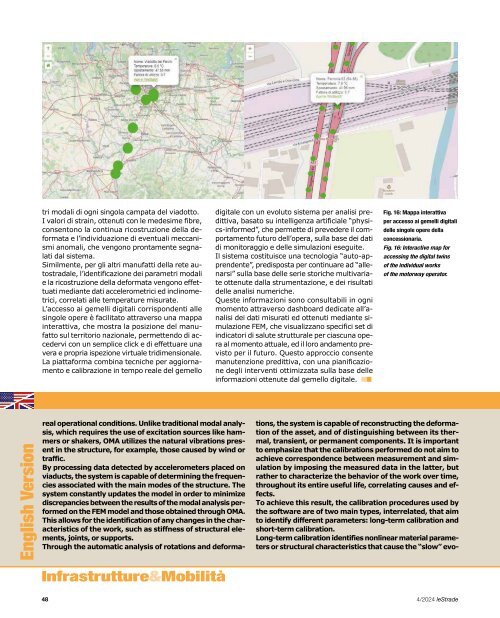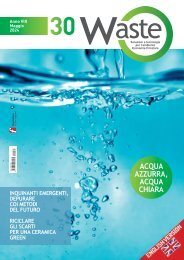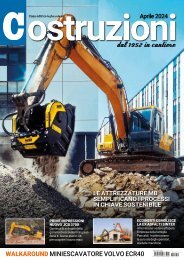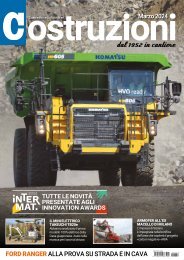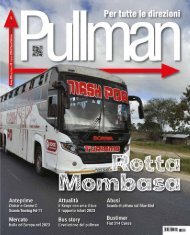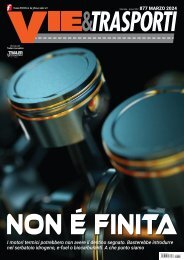leStrade n. 1956 aprile 2024
INFRASTRUTTURE Milano Serravalle Milano Tangenziali La sicurezza in tempo reale GALLERIE La Realtà Virtuale “avanza” nelle gallerie BBT
INFRASTRUTTURE
Milano Serravalle Milano Tangenziali La sicurezza in tempo reale
GALLERIE
La Realtà Virtuale “avanza” nelle gallerie BBT
- No tags were found...
Create successful ePaper yourself
Turn your PDF publications into a flip-book with our unique Google optimized e-Paper software.
English Version<br />
tri modali di ogni singola campata del viadotto.<br />
I valori di strain, ottenuti con le medesime fibre,<br />
consentono la continua ricostruzione della deformata<br />
e l’individuazione di eventuali meccanismi<br />
anomali, che vengono prontamente segnalati<br />
dal sistema.<br />
Similmente, per gli altri manufatti della rete autostradale,<br />
l’identificazione dei parametri modali<br />
e la ricostruzione della deformata vengono effettuati<br />
mediante dati accelerometrici ed inclinometrici,<br />
correlati alle temperature misurate.<br />
L’accesso ai gemelli digitali corrispondenti alle<br />
singole opere è facilitato attraverso una mappa<br />
interattiva, che mostra la posizione del manufatto<br />
sul territorio nazionale, permettendo di accedervi<br />
con un semplice click e di effettuare una<br />
vera e propria ispezione virtuale tridimensionale.<br />
La piattaforma combina tecniche per aggiornamento<br />
e calibrazione in tempo reale del gemello<br />
digitale con un evoluto sistema per analisi predittiva,<br />
basato su intelligenza artificiale “physics-informed”,<br />
che permette di prevedere il comportamento<br />
futuro dell’opera, sulla base dei dati<br />
di monitoraggio e delle simulazioni eseguite.<br />
Il sistema costituisce una tecnologia “auto-apprendente”,<br />
predisposta per continuare ad “allenarsi”<br />
sulla base delle serie storiche multivariate<br />
ottenute dalla strumentazione, e dei risultati<br />
delle analisi numeriche.<br />
Queste informazioni sono consultabili in ogni<br />
momento attraverso dashboard dedicate all’analisi<br />
dei dati misurati ed ottenuti mediante simulazione<br />
FEM, che visualizzano specifici set di<br />
indicatori di salute strutturale per ciascuna opera<br />
al momento attuale, ed il loro andamento previsto<br />
per il futuro. Questo approccio consente<br />
manutenzione predittiva, con una pianificazione<br />
degli interventi ottimizzata sulla base delle<br />
informazioni ottenute dal gemello digitale. nn<br />
Fig. 16: Mappa interattiva<br />
per accesso ai gemelli digitali<br />
delle singole opere della<br />
concessionaria.<br />
Fig. 16: Interactive map for<br />
accessing the digital twins<br />
of the individual works<br />
of the motorway operator.<br />
real operational conditions. Unlike traditional modal analysis,<br />
which requires the use of excitation sources like hammers<br />
or shakers, OMA utilizes the natural vibrations present<br />
in the structure, for example, those caused by wind or<br />
traffic.<br />
By processing data detected by accelerometers placed on<br />
viaducts, the system is capable of determining the frequencies<br />
associated with the main modes of the structure. The<br />
system constantly updates the model in order to minimize<br />
discrepancies between the results of the modal analysis performed<br />
on the FEM model and those obtained through OMA.<br />
This allows for the identification of any changes in the characteristics<br />
of the work, such as stiffness of structural elements,<br />
joints, or supports.<br />
Through the automatic analysis of rotations and deformations,<br />
the system is capable of reconstructing the deformation<br />
of the asset, and of distinguishing between its thermal,<br />
transient, or permanent components. It is important<br />
to emphasize that the calibrations performed do not aim to<br />
achieve correspondence between measurement and simulation<br />
by imposing the measured data in the latter, but<br />
rather to characterize the behavior of the work over time,<br />
throughout its entire useful life, correlating causes and effects.<br />
To achieve this result, the calibration procedures used by<br />
the software are of two main types, interrelated, that aim<br />
to identify different parameters: long-term calibration and<br />
short-term calibration.<br />
Long-term calibration identifies nonlinear material parameters<br />
or structural characteristics that cause the “slow” evo-<br />
Riferimenti<br />
[1] Linee Guida per la Classificazione del Rischio, la valutazione della sicurezza<br />
ed il monitoraggio dei ponti esistenti, Allegate al parere del Consiglio Superiore<br />
dei LL.PP. n. 54/2022<br />
[2] M. Martinelli, M. Ferrario, SYNOPTIC FIBER OPTIC SENSOR”, Patent<br />
[3] M.Martinelli, The dynamical behaviour of a single-mode optical fiber strain-gage<br />
IEEE Journal of Quantum Electronics, QE 18, 666, (1982)<br />
[4] C. Liguori, M. Martinelli, Integral phase modulation properties of a single mode<br />
optical fiber subjected to controlled vibrations, Applied Optics, 20, 4319, (1981)<br />
[5] NTC 2018 – Testo aggiornato delle norme tecniche per le costruzioni (NTC2018),<br />
di cui alla legge 5 novembre 1971, n. 1086, alla legge 2 febbraio 1974, n. 64,<br />
al decreto del Presidente della Repubblica 6 giugno 2001, n. 380, ed al decreto-legge<br />
28 maggio 2004, n. 136, convertito, con modificazioni, dalla legge 27<br />
luglio 2004, n. 186.<br />
[6] Circolare NTC 2018 – CIRCOLARE 21 gennaio 2019, n. 7 C.S.LL.PP. Istruzioni<br />
per l’applicazione dell’«Aggiornamento delle “Norme tecniche per le costruzioni”»<br />
di cui al decreto ministeriale 17 gennaio 2018.<br />
[7] ANSFISA Istruzioni Operative per l’applicazione delle Linee guida per la classificazione<br />
e gestione del rischio, la valutazione della sicurezza ed il monitoraggio<br />
dei ponti esistenti.<br />
[8] WeStatiX SHM – westatix.com – Piattaforma per monitoraggio e manutenzione<br />
predittiva delle infrastrutture.<br />
lution of the behavior of the work, over long periods. Depending<br />
on the type of artifact, this calibration may involve<br />
identifying parameters that govern the evolution of stiffness,<br />
creep and shrinkage evolution laws, damage, corrosion,<br />
or fatigue.<br />
The data is processed to eliminate from the measurements<br />
the effects due to transient events, such as temperature variations<br />
or acting loads. The calibration uses the complete series<br />
of available measurements, in order to continue improving<br />
the material laws governing their evolution over time.<br />
Short-term calibration identifies parameters that govern<br />
rapid changes in measured data. Examples can include the<br />
thermomechanical characteristics of materials, which govern<br />
the structure’s behavior as temperature changes (e.g.,<br />
displacements due to temperature gradients), but also acting<br />
loads (e.g., from traffic), which cause sudden and usually<br />
reversible (elastic) deformations and displacements, as<br />
well as scenarios of sudden damage, which the platform is<br />
designed to detect and quantify accurately.<br />
Some results<br />
To validate the calculation models, simulation of the available<br />
load tests was conducted. For the Parchi Viaduct, these<br />
were carried out during May 2021. During these tests, various<br />
spans of the viaduct were loaded with a maximum of 6<br />
trucks weighing about 30-32 tons each, arranged as depicted<br />
in the figure. The displacements of the deck were detected<br />
by topographic survey.<br />
The numerical simulations were performed using the model<br />
previously described, integrated into the digital twin.<br />
In particular, the aim was to accurately describe the position<br />
of the trucks by applying the tire prints directly onto the<br />
deck, also considering the distribution effects in<br />
the asphalt layer as specified by the regulations.<br />
The simulations accounted for the different<br />
heights of the piers corresponding to the analyzed<br />
spans, introducing two new heights, equal<br />
to 15m and 9m. The results show an increase of<br />
about 20% in terms of maximum deflection, for<br />
the same load, in correspondence with the taller<br />
piers.<br />
The simulations demonstrated excellent adherence<br />
to the real behavior of the structure, with<br />
negligible discrepancies both in terms of maximum<br />
deck deflection and in terms of the trend<br />
of displacements.<br />
The distributed fiber optic system installed on<br />
the Parchi Viaduct enables the acquisition of<br />
strain rate values (or the derivative of deformation<br />
over time) and strain values (deformation<br />
or elongation of the fiber).<br />
The strain rate values are automatically processed<br />
by the system, allowing for the dynamic<br />
characterization and identification of modal parameters<br />
for each individual span of the viaduct.<br />
The strain values, obtained with the same fibers, allow for the<br />
continuous reconstruction of the deformation and the detection<br />
of any anomalous mechanisms, which are promptly reported<br />
by the system.<br />
Similarly, for other artifacts of the highway network, the identification<br />
of modal parameters and the reconstruction of the<br />
deformation are performed using accelerometric and inclinometric<br />
data, correlated with measured temperatures.<br />
Access to the digital twins corresponding to individual works<br />
is facilitated through an interactive map, which shows the position<br />
of the asset on the national territory, allowing access<br />
with a simple click and enabling a true three-dimensional virtual<br />
inspection.<br />
The platform combines techniques for real-time updating<br />
and calibration of the digital twin with an advanced system<br />
for predictive analysis, based on “physics-informed” artificial<br />
intelligence, which allows predicting the future behavior<br />
of the work, based on monitoring data and performed simulations.<br />
The system constitutes a “self-learning” technology, prepared<br />
to continue “training” based on the multivariate historical<br />
series obtained from the instrumentation, and the results<br />
of numerical analyses.<br />
This information can be consulted at any time through dashboards<br />
dedicated to the analysis of measured data and obtained<br />
through FEM simulation, displaying specific sets of<br />
structural health indicators for each work at the current moment,<br />
and their expected trend for the future. This approach<br />
allows for predictive maintenance, with planning of interventions<br />
optimized based on the information obtained from the<br />
digital twin.<br />
Infrastrutture&Mobilità<br />
48 4/<strong>2024</strong> <strong>leStrade</strong><br />
<strong>leStrade</strong> 4/<strong>2024</strong> 49


